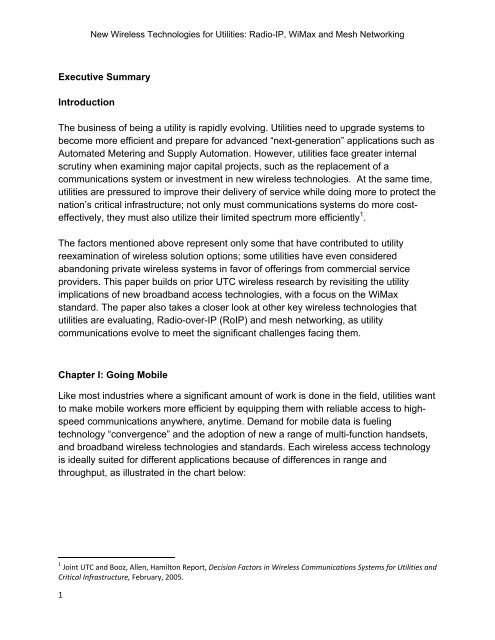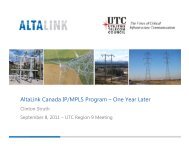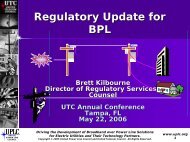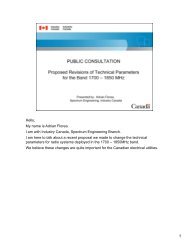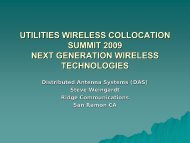Executive Summary Introduction The business of being a utility is ...
Executive Summary Introduction The business of being a utility is ...
Executive Summary Introduction The business of being a utility is ...
- No tags were found...
Create successful ePaper yourself
Turn your PDF publications into a flip-book with our unique Google optimized e-Paper software.
New Wireless Technologies for Utilities: Radio-IP, WiMax and Mesh Networking<strong>Executive</strong> <strong>Summary</strong><strong>Introduction</strong><strong>The</strong> <strong>business</strong> <strong>of</strong> <strong>being</strong> a <strong>utility</strong> <strong>is</strong> rapidly evolving. Utilities need to upgrade systems tobecome more efficient and prepare for advanced “next-generation” applications such asAutomated Metering and Supply Automation. However, utilities face greater internalscrutiny when examining major capital projects, such as the replacement <strong>of</strong> acommunications system or investment in new wireless technologies. At the same time,utilities are pressured to improve their delivery <strong>of</strong> service while doing more to protect thenation’s critical infrastructure; not only must communications systems do more costeffectively,they must also utilize their limited spectrum more efficiently 1 .<strong>The</strong> factors mentioned above represent only some that have contributed to <strong>utility</strong>reexamination <strong>of</strong> wireless solution options; some utilities have even consideredabandoning private wireless systems in favor <strong>of</strong> <strong>of</strong>ferings from commercial serviceproviders. Th<strong>is</strong> paper builds on prior UTC wireless research by rev<strong>is</strong>iting the <strong>utility</strong>implications <strong>of</strong> new broadband access technologies, with a focus on the WiMaxstandard. <strong>The</strong> paper also takes a closer look at other key wireless technologies thatutilities are evaluating, Radio-over-IP (RoIP) and mesh networking, as <strong>utility</strong>communications evolve to meet the significant challenges facing them.Chapter I: Going MobileLike most industries where a significant amount <strong>of</strong> work <strong>is</strong> done in the field, utilities wantto make mobile workers more efficient by equipping them with reliable access to highspeedcommunications anywhere, anytime. Demand for mobile data <strong>is</strong> fuelingtechnology “convergence” and the adoption <strong>of</strong> new a range <strong>of</strong> multi-function handsets,and broadband wireless technologies and standards. Each wireless access technology<strong>is</strong> ideally suited for different applications because <strong>of</strong> differences in range andthroughput, as illustrated in the chart below:1 Joint UTC and Booz, Allen, Hamilton Report, Dec<strong>is</strong>ion Factors in Wireless Communications Systems for Utilities andCritical Infrastructure, February, 2005.1
New Wireless Technologies for Utilities: Radio-IP, WiMax and Mesh NetworkingRange versus throughput, wireless data communicationsSource: Mobiletrax, LLCUtilities worldwide continue to build-out mobile capabilities as electric, natural gas andwater companies integrate computing capabilities across their organizations and intothe field. According to a Sierra Energy Group's (SEG), starting in 2005 and by the end<strong>of</strong> 2008, 650 <strong>of</strong> the largest utilities in the U.S. and Canada (in terms <strong>of</strong> total end-usecustomers), will have a minimum <strong>of</strong>$47.43 million worth <strong>of</strong> mobile projects under way:Source: Sierra Energy Group2
New Wireless Technologies for Utilities: Radio-IP, WiMax and Mesh NetworkingWiMax for Utilities<strong>The</strong> Worldwide Interoperability for Microwave Access (WiMAX) standard <strong>is</strong> a wirelessindustry solution for extending broadband access over longer d<strong>is</strong>tances, and to morelocations, than Wi-Fi. In its early form, WiMAX enables the delivery <strong>of</strong> last mile wirelessbroadband access as an alternative to wired broadband like cable and DSL. As theWiMax standard evolves, however, it will provide mobile wireless broadbandconnectivity without the need for direct line-<strong>of</strong>-sight with a base station, in a typical cellradius deployment <strong>of</strong> three to ten kilometersWith a d<strong>is</strong>tributed WiMAX network architecture, the WiMAX system becomes anextension <strong>of</strong> the IP network to the mobile user. Leveraging simple IP-based backhaulconnections, service providers can very readily service a myriad <strong>of</strong> WiMAX base sites(e.g. large, medium, sectorized, omni, micro, pico) for varying coverage and capacitypr<strong>of</strong>iles addressing outside environments, inside buildings, and fixed and, eventually,mobile connections:Source: Intel WiMax Solutions Div<strong>is</strong>ion3
New Wireless Technologies for Utilities: Radio-IP, WiMax and Mesh NetworkingWiMAX could be useful to utilities in a number <strong>of</strong> ways: WiMAX can be used for wirelessbackhaul for Wi-Fi or other systems such as 3G wireless, and WiMax can perhapscombine with mesh architecture (see Chapter III) to create an AMI network deployment.WiMax <strong>is</strong> a standard, not a product, and <strong>is</strong> very specific to the 2.5 Ghz frequency in theU.S., where only two companies -- Clearwire and Sprint-Nextel -- hold frequencylicenses. However, WiMax base stations and equipment can be modified to work with avariety <strong>of</strong> frequencies, and some utilities have become interested in WiMax-liketechnology for use in proprietary, core communications systems.New auctions <strong>of</strong> 700 Mhz frequency formerly allocated to telev<strong>is</strong>ion usage may expandthe landscape for <strong>utility</strong> access to broadband technologies such as WiMax. Although theFCC has sided against allocating 700 Mhz spectrum for the use <strong>of</strong> critical infrastructureentities, it <strong>is</strong> likely that spectrum licensees will seek to partner with infrastructure-richutilities to help meet aggressive FCC build-out requirements. Critical Infrastructure (CI)entities like utilities could also benefit from mandated wholesale access to nationwidenetworks that will be built by the eventual spectrum licensees.Chapter II: Radio-IP for UtilitiesInternet Protocol (IP) based architecture represents the next generation in Land MobileRadio systems. Radio-over-IP (RoIP) refers to a suite <strong>of</strong> technologies that allows twowayradio traffic to be transmitted over an internet protocol (IP) network.Motorola “Harmony” System IntegrationSource: Motorola4
New Wireless Technologies for Utilities: Radio-IP, WiMax and Mesh Networking<strong>The</strong> benefits to utilities <strong>of</strong> upgrading to IP-based radio systems include:• Cost savings through reduction or elimination <strong>of</strong> leased line costs, and reductionor elimination <strong>of</strong> channel equipment and external interfaces;• Redundancy through the routing capability incorporated in the IP packet structure• Enables interoperability between radio, telephone and data communicationsystems• Enables efficient collaboration between staff and across organizations• Operate more efficiently and cost effectively, reduce long d<strong>is</strong>tance and mobilecall costs• Reduces geographical limitation <strong>of</strong> two way radios• Leverages investment in ex<strong>is</strong>ting radio and network infrastructure.• Simplification through standardization and commonality <strong>of</strong> equipment,augmented by the use <strong>of</strong> <strong>of</strong>f-the-shelf networking equipment.<strong>The</strong>se benefits are difficult to quantify, making the <strong>business</strong> case for Radio-IP upgradesdifficult to sell to senior <strong>utility</strong> management. Utility dec<strong>is</strong>ions to upgrade to Radio-IPusually are made either because the <strong>utility</strong> wants to do more with its system – combinevoice and data traffic, for instance -- or an old, conventional system reaches the end <strong>of</strong>its practical life. Utilities implementing applications such as Automated Meter Reading(AMR), or a similar investment, must implement an IP-based platform that can supportthe needed applications.Chapter III: Making it MeshMesh networking <strong>is</strong> a design topology where nodes pass information from node to nodeto eventually get information out <strong>of</strong> the network or into a point in the network; everynode in the network essentially serves as a repeater. Mesh networking topology lookslike a web, as opposed to a traditional “star” topology where peripheral nodes connectto a central node. Th<strong>is</strong> architecture <strong>of</strong>fers the advantage <strong>being</strong> simple to set up, thusdecreasing costs, and it <strong>is</strong> very resilient and reliable, in some cases achieving 100%reliability, because the nodes automatically re-route if data traffic <strong>is</strong> interrupted.5
New Wireless Technologies for Utilities: Radio-IP, WiMax and Mesh NetworkingMesh ArchitectureSource: TechOnlineUtilities are studying meshing architecture primarily for use in AMR meteringapplications where cost <strong>of</strong> installation and maintenance <strong>is</strong> an important factor. <strong>The</strong>meters at each person’s house communicate with one another, forming a network thateventually brings the meter data to a gateway that routes the information to the correctarea <strong>of</strong> the <strong>utility</strong>.ConclusionDespite the challenges that come with upgrading a wireless system, substantial costand <strong>business</strong> enhancement can be achieved by improving the capabilities <strong>of</strong> a <strong>utility</strong>’swireless system. Advanced wireless access technologies such as WiMax , meshnetworking and Radio-IP can support the delivery <strong>of</strong> new products, services andapplications such as AMR / AMI, while simplify network and application integrationacross the <strong>utility</strong>.<strong>The</strong> extent to which utilities implement new wireless technologies will vary, butcontinued <strong>utility</strong> investment in private, wide area, m<strong>is</strong>sion-critical voice and datanetworks appears unavoidable for the foreseeable future; reliance on commercialservices does not appear to be a long term solution to <strong>utility</strong> needs for ubiquitouscoverage and reliabiltiy. Utilities will have to invest in integrated voice and data6
New Wireless Technologies for Utilities: Radio-IP, WiMax and Mesh Networkingbackbone capabilities across the entirety <strong>of</strong> their service areas to enable nextgeneration,m<strong>is</strong>sion-critical communications. Utility backbone wireless networks willlikely emphasize capacity, and reliability at lower speeds.Utilities will likely, however, make use <strong>of</strong> high-speed data public networks when andwhere there <strong>is</strong> acceptable coverage, and where greater speed and flexibility <strong>is</strong> usefuland available at reasonable cost. Utilities will likely make increased use <strong>of</strong> new,converged, handheld multi-carrier radios that perform nearly seamlessly on public andprivate networks, and take advantage <strong>of</strong> the most efficient access technologies for givenapplications, d<strong>is</strong>tances and unique circumstances <strong>of</strong> each <strong>utility</strong>.7


